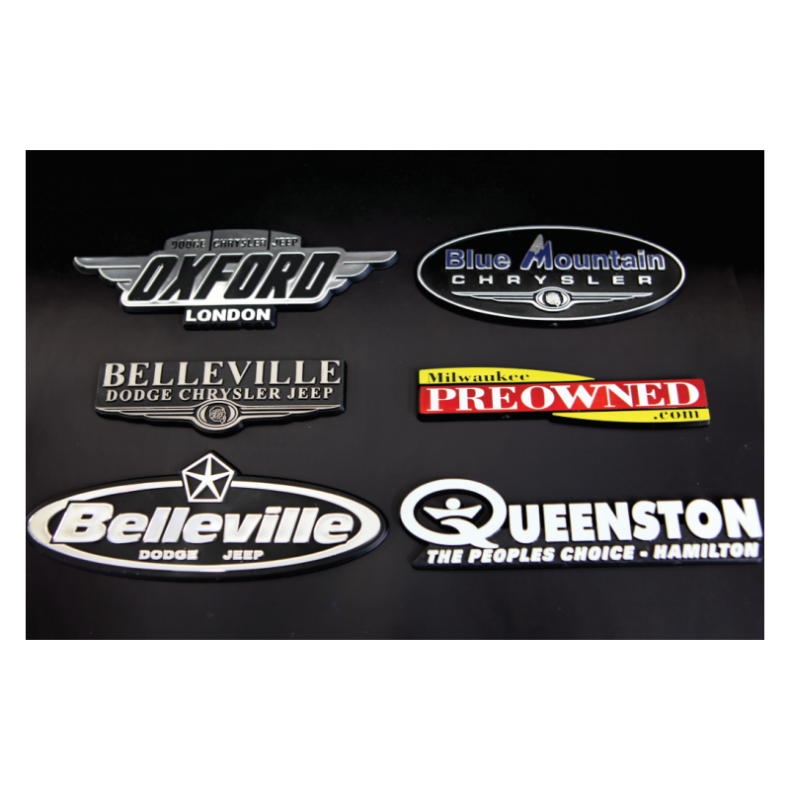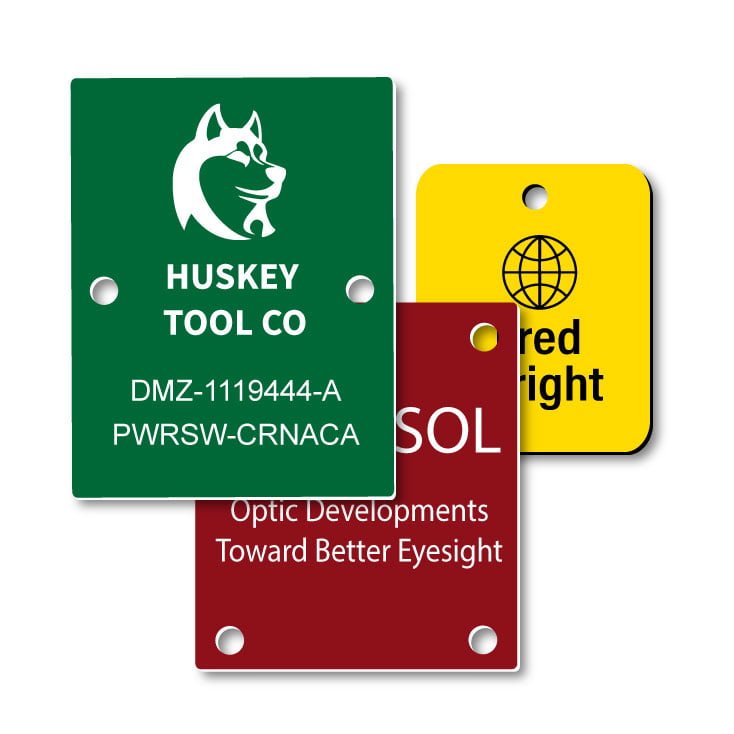A Buyer’s Guide to Choosing the Right Plastic Nameplates for Your Needs
How Plastic Nameplates Are Produced: A Comprehensive Overview to Their Manufacturing Process
The manufacturing of plastic nameplates includes several accurate steps, beginning from the choice of suitable products to the last complements. Each phase is important, making certain the product fulfills details requirements for longevity and aesthetics. Various production techniques play a significant duty in crafting these nameplates. Understanding these procedures can clarify the complexities behind what may appear like a basic product. What variables add to the quality and customization of these nameplates?
Comprehending Plastic Products Utilized for Nameplates

The Style Refine: From Idea to Prototype
The design process for plastic nameplates begins with a clear idea that overviews the general creation. Designers work together with clients to specify the objective, design, and specific requirements of the nameplate. This initial phase includes conceptualizing sessions, laying out ideas, and selecting shades and typefaces that align with branding goals.Once the principle is developed, developers use computer-aided style (CAD) software to develop detailed digital representations. These prototypes enable visualization and adjustments before moving on. Feedback from stakeholders is indispensable during this stage, as it helps improve the layout to fulfill expectations.After settling the electronic prototype, a physical model may be created, commonly via strategies like 3D printing. This substantial depiction allows further analysis of appearances and functionality. Generally, the layout process is a vital step that lays the foundation for the effective production of high-quality plastic nameplates.
Reducing and Shaping the Plastic
In the cutting and forming stage of plastic nameplate manufacturing, the choice of materials plays an important duty in determining the last product's high quality and resilience (Plastic Nameplates). Various accuracy cutting techniques, such as laser cutting and CNC machining, warranty that the plastic is shaped with precision and uniformity. This mix of mindful material choice and progressed reducing approaches is crucial for generating premium nameplates

Product Selection Process
Selecting the ideal product is important for generating high-quality plastic nameplates. Different sorts of plastics are offered, each offering distinctive benefits and characteristics. Typical options include acrylic, polycarbonate, and PVC. Acrylic is favored for its clearness and UV resistance, making it suitable for outside applications. Polycarbonate, recognized for its durability and effect resistance, is appropriate for atmospheres that call for improved protection. PVC is often selected for its cost-effectiveness and flexibility in style. The option procedure additionally considers elements such as thickness, color, and surface surface, which can significantly affect the final look and functionality of the nameplate. Inevitably, the chosen material should align with the planned usage and aesthetic objectives of the plastic nameplate.
Accuracy Trimming Techniques
While picking the proper material prepares, precision cutting techniques play a necessary role in forming the plastic nameplates right into their final types. Numerous approaches, including laser cutting, CNC milling, and die cutting, are employed to accomplish accuracy and consistency. Laser cutting utilizes focused light to create clean sides and intricate designs, suitable for complex patterns. CNC milling uses flexibility by eliminating excess product with accuracy, fitting various thicknesses and shapes. Die reducing, on the various other hand, permits automation of uniform items, boosting efficiency. Each method is selected based upon the layout requirements and the wanted surface, guaranteeing that the end product satisfies high quality criteria and consumer assumptions while maintaining resilience and aesthetic allure.
Printing Techniques for Customization
Exactly how can producers attain dynamic and accurate layouts on plastic nameplates? The response depends on different printing techniques tailored for personalization. Digital printing has gotten appeal as a result of its ability to create complex styles and high-resolution images straight onto plastic surfaces. This approach enables fast turnaround times and very little setup costs, making it perfect for brief runs and customized orders.Screen printing stays an additional widely used technique, particularly for larger quantities. It involves producing a stencil and applying layers of ink, leading to rich colors and durability. UV printing, which utilizes ultraviolet light to treat the ink, is also reliable, supplying superb attachment and resistance to fading.Additionally, pad printing provides versatility for irregularly designed nameplates, permitting detailed layouts on challenging surfaces. These printing methods make it possible for manufacturers to meet diverse customer needs while guaranteeing high quality and durability in their plastic nameplate products.
Surface Area Treatments and Finishing Options

Quality Control Steps in Manufacturing
Ensuring the highest standards of top quality control throughout the manufacturing of plastic nameplates is vital for preserving product integrity and customer contentment. Makers apply extensive examination procedures at different stages of the manufacturing procedure. Originally, raw products undergo extensive testing to confirm page they fulfill specs for sturdiness and color uniformity. During the molding phase, automated systems keep an eye on criteria such as temperature level and stress to protect against defects.In enhancement, visual evaluations are conducted to determine any kind of surface blemishes or imbalances. Once the nameplates are generated, they are subjected to practical examinations, including attachment examinations for printed components and stress and anxiety tests for longevity. Quality control teams usually utilize analytical tasting techniques to evaluate batches, making sure that any kind of inconsistencies from criteria are without delay addressed. This thorough technique not only boosts item high quality however additionally fosters trust fund with clients, affirming the manufacturer's commitment to excellence in every nameplate generated.
Packaging and Distribution of Finished Nameplates
The product packaging and circulation of finished plastic nameplates are vital actions in ensuring they get to customers in optimal problem. Different product packaging materials are picked to safeguard the nameplates during transit, while shipping techniques are carefully selected based upon efficiency and cost-effectiveness. Furthermore, efficient storage services are executed to keep top quality till the nameplates are delivered.
Product Packaging Products Made Use Of
When dispersing ended up plastic nameplates, selecting suitable packaging products is important to guarantee their defense during transportation. Generally utilized products consist of bubble wrap, foam extra padding, and cardboard boxes, all designed to support the nameplates versus shocks and impacts. Bubble wrap provides a versatile obstacle, while foam extra padding guarantees that nameplates stay safely in location, minimizing the threat of scratches or breakage. In addition, sturdy cardboard boxes are utilized to contain the nameplates, providing architectural support and security from external components. Tags may be applied to indicate handling directions or delicate materials, even more boosting security during transport. In general, utilizing high-quality packaging products substantially contributes to the integrity and discussion of the finished plastic nameplates upon arrival at their location.
Delivering Approaches Utilized
Reliable circulation of finished plastic nameplates counts on various delivery approaches that assure timely and safe and secure distribution. Business commonly use courier solutions, freight shipping, and post offices, depending on the size, weight, and destination of the plans. For neighborhood distributions, copyright services offer fast transit, ensuring their explanation nameplates reach clients swiftly. For larger orders, products delivery is favored, making use of trucks or delivery containers to move mass amounts efficiently. Postal solutions act as an economical alternative for smaller sized shipments, especially for residential distributions. All delivery approaches focus on safety packaging to avoid damages throughout transportation. Tracking systems are also made use of to keep an eye on shipments, supplying clients with real-time updates and reassurance regarding the standing of their orders.
Storage Space Solutions Implemented

Regularly Asked Concerns
What Sorts Of Services Typically Use Plastic Nameplates?
Plastic nameplates are typically utilized by numerous services, including workplaces, hospitals, colleges, and manufacturing facilities. These nameplates serve crucial features such as identification, details screen, and branding, contributing to business performance and professional appearance throughout varied settings.
How much time Does the Entire Production Refine Take?
The production procedure period differs based upon complexity and quantity, typically varying from a couple of days to numerous weeks. Aspects influencing this timeline include design authorization, material availability, and production methods utilized by the company.
Can Plastic Nameplates Be Recycled After Usage?
Plastic nameplates can be reused, offered they are made from recyclable materials. The accessibility of recycling programs and local policies might affect their recyclability. Proper disposal methods are essential to assure reliable recycling.
What Are the Environmental Effects of Plastic Nameplate Manufacturing?
The environmental effects of plastic nameplate production consist of carbon exhausts, source depletion, and contamination from manufacturing processes. Plastic Nameplates. Additionally, improper disposal contributes to plastic waste, negatively affecting ecosystems and wildlife, highlighting the requirement for sustainable techniques
Are There Any Safety Interest In Plastic Nameplates?
Safety issues pertaining to plastic nameplates primarily entail potential chemical direct exposure throughout production and the risk of products breaking down in time, which may bring about hazardous substances being launched, influencing both human health and the environment. While different products can be used for nameplates, plastic remains a popular option due to its adaptability and durability. In the cutting and forming stage of plastic nameplate production, the choice of products plays an important function in establishing the final product's high quality and sturdiness. Choosing the ideal material is essential for creating premium plastic nameplates. While selecting the ideal material lays the groundwork, accuracy reducing techniques play a vital function in forming the plastic nameplates right into their final kinds. When dispersing ended up plastic nameplates, choosing proper packaging products is vital to ensure their protection throughout transportation.